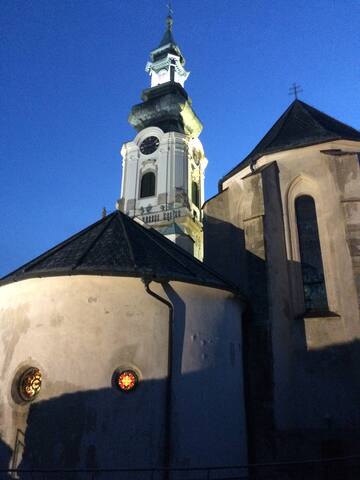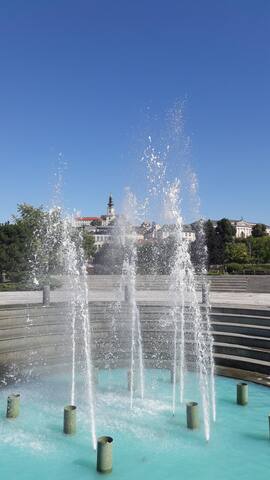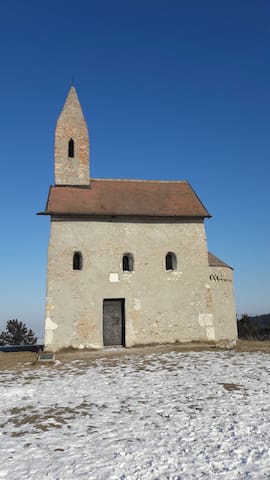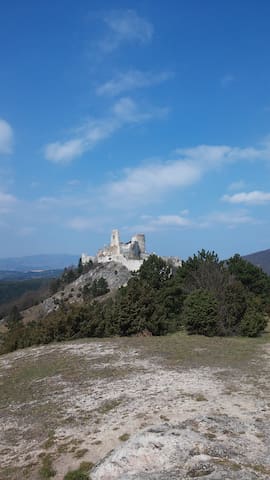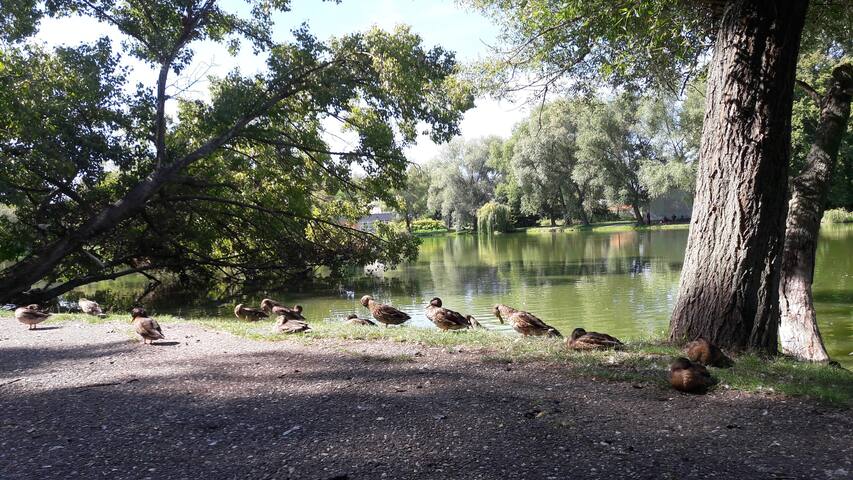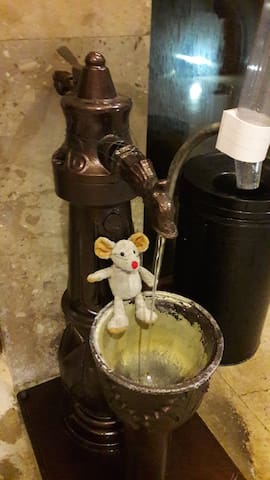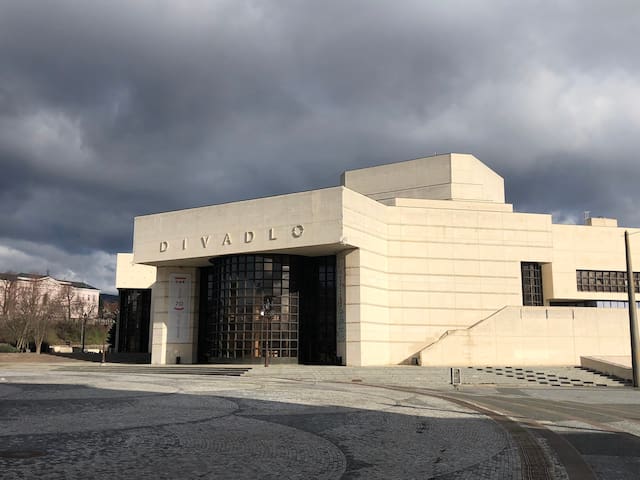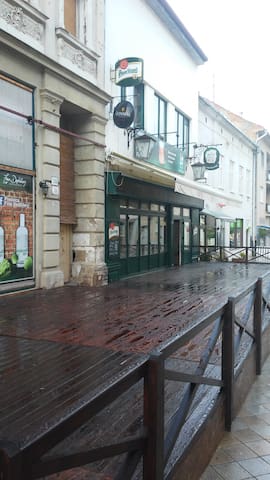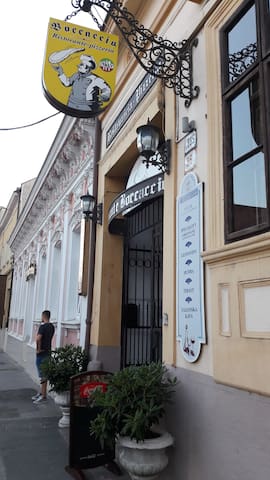Prehliadka pamätihodností
The Castle of Nitra is considered to be one of the most signifi cant features of Nitra. It was built on a limestone rock, which is surrounded by the meander of the Nitra River from three sides. The Castle of Nitra is a cultural heritage and together with the Upper Town on the southern slope of the castle hill was proclaimed a Town Conservation Reserve. The Castle of Nitra consists of four independent parts: the cathedral, bishop palace, outbuildings and outer walls with one entrance gate.
The oldest surviving part of the Cathedral is the Romanesque church of St Emeram from the 11th or 12th century. It was rebuilt after fire in the second half of the 13th century and after Matúš Čáks soldiers destroyed it, a new Gothic church was built next to it in 1317. From then on it served as what is called ”trustworthy” place of chapter and later as the treasury of the cathedral. Today, it forms together with the Upper and Lower Churches the most valuable structure in the area of the Castle - the Bishops Cathedral.
The originally Gothic Upper Church was built in the years 1333-1335 and three centuries later the Lower Church was added to it. A wide staircase connects both of them. The appearance of the Cathedral as we know it now, is from the years 1710-1736 and its interior is also from that time. Among the most valuable monuments of the interior is the main altar of the Lower Church made by the Austrian sculptor J. Pernegger who used the painting of D. Voltera as a model.
The originally Gothic Bishops Palace standing by these sacral buildings obtained its Late Baroque appearance in the second half of the 18th century.
Its outer fortifications with the oldest parts from the Romanesque period are especially interesting. The legendary Vazilova veža tower with square ground plan was several times rebuilt and adapted in the Romantic style. Allegedly the Hungarian Prince Vazul was imprisoned in this tower.
The Castle area and the Bishops Cathedral of St Emeram are accessible to public.
19 lokal ang nagrerekomenda
Kastilyong Nitra
The Castle of Nitra is considered to be one of the most signifi cant features of Nitra. It was built on a limestone rock, which is surrounded by the meander of the Nitra River from three sides. The Castle of Nitra is a cultural heritage and together with the Upper Town on the southern slope of the castle hill was proclaimed a Town Conservation Reserve. The Castle of Nitra consists of four independent parts: the cathedral, bishop palace, outbuildings and outer walls with one entrance gate.
The oldest surviving part of the Cathedral is the Romanesque church of St Emeram from the 11th or 12th century. It was rebuilt after fire in the second half of the 13th century and after Matúš Čáks soldiers destroyed it, a new Gothic church was built next to it in 1317. From then on it served as what is called ”trustworthy” place of chapter and later as the treasury of the cathedral. Today, it forms together with the Upper and Lower Churches the most valuable structure in the area of the Castle - the Bishops Cathedral.
The originally Gothic Upper Church was built in the years 1333-1335 and three centuries later the Lower Church was added to it. A wide staircase connects both of them. The appearance of the Cathedral as we know it now, is from the years 1710-1736 and its interior is also from that time. Among the most valuable monuments of the interior is the main altar of the Lower Church made by the Austrian sculptor J. Pernegger who used the painting of D. Voltera as a model.
The originally Gothic Bishops Palace standing by these sacral buildings obtained its Late Baroque appearance in the second half of the 18th century.
Its outer fortifications with the oldest parts from the Romanesque period are especially interesting. The legendary Vazilova veža tower with square ground plan was several times rebuilt and adapted in the Romantic style. Allegedly the Hungarian Prince Vazul was imprisoned in this tower.
The Castle area and the Bishops Cathedral of St Emeram are accessible to public.
The city of Nitra has a long history with records of its name dating back to 870. Before this time, a fortification was built on Castle Hill by Madarovce people with Slavic people arriving in the area towards the end of the 5th century. This area then became known as the Principality of Nitra or the Duchy of Nitra in the 9th century. The king, Pribina, is known to be the first Slavic ruler to build a church in the principality. This principality encompassed cities from Bratislava to Tokaj so it is incredibly significant in Slovakia’s history. The Principality of Nitra and the Principality of Moravia then merged to form the Great Moravian Empire. During this time, the fortification on Castle Hill was replaced by Nitra Castle. The Great Moravian ruler, Svätopluk I, created the first diocese in Slovakia and this is when Nitra reached its heyday. After this time, Nitra became part of Lower Hungary and was attacked by Czech, Ottoman, and Turkish armies as well as anti-Habsburg uprisings. Today, Nitra is the seat of Nitra region in Slovakia and is home to several churches, Nitra Castle, Zobor Pyramid, and tasty cafes and restaurants. Whether you are taking a hike along Zobor Mountain, stopping for a bite to eat, or exploring the city center, Nitra’s rich history will be part of your experience.
Turist information center Nitra
Štefánikova street 1
https://www.nitra.eu/www/index.php?lang=en
8 lokal ang nagrerekomenda
Nitra
The city of Nitra has a long history with records of its name dating back to 870. Before this time, a fortification was built on Castle Hill by Madarovce people with Slavic people arriving in the area towards the end of the 5th century. This area then became known as the Principality of Nitra or the Duchy of Nitra in the 9th century. The king, Pribina, is known to be the first Slavic ruler to build a church in the principality. This principality encompassed cities from Bratislava to Tokaj so it is incredibly significant in Slovakia’s history. The Principality of Nitra and the Principality of Moravia then merged to form the Great Moravian Empire. During this time, the fortification on Castle Hill was replaced by Nitra Castle. The Great Moravian ruler, Svätopluk I, created the first diocese in Slovakia and this is when Nitra reached its heyday. After this time, Nitra became part of Lower Hungary and was attacked by Czech, Ottoman, and Turkish armies as well as anti-Habsburg uprisings. Today, Nitra is the seat of Nitra region in Slovakia and is home to several churches, Nitra Castle, Zobor Pyramid, and tasty cafes and restaurants. Whether you are taking a hike along Zobor Mountain, stopping for a bite to eat, or exploring the city center, Nitra’s rich history will be part of your experience.
Turist information center Nitra
Štefánikova street 1
https://www.nitra.eu/www/index.php?lang=en
The urban district of Nitra is Dražovce, an important archaeological site with Slav settlement and cemetery from the time of the Great Moravian Empire.
The well-preserved picturesque Romanesque church of St Michael from the beginning of the 12th century is the historical attractiveness of the village.
This repeatedly adapted church was built on the site of a fort from the Iron Age. A short walk leading to the church will also offer you an interesting view of the town of Nitra and its environs.
Dražovský kostolík (románsky kostol svätého Michala archanjela)
654 Pod kostolíkomThe urban district of Nitra is Dražovce, an important archaeological site with Slav settlement and cemetery from the time of the Great Moravian Empire.
The well-preserved picturesque Romanesque church of St Michael from the beginning of the 12th century is the historical attractiveness of the village.
This repeatedly adapted church was built on the site of a fort from the Iron Age. A short walk leading to the church will also offer you an interesting view of the town of Nitra and its environs.
The site of one of the most sensational - and sensationalized - serial murders in history, Hrad Cachtice stands now empty and mostly ruined.
In 1611 the household of the Hungarian countess Elizabeth Bathory was accused of torturing and killing as many as 600 young women within the walls of this castle. Over time, the story began to include accusations of sexual attacks and turned Elizabeth into a aging beauty obsessed by the idea of eternal youth found in the blood of virgins. Now perhaps irretrievably mired in myth and speculation, it may be impossible to completely separate fact from fiction.
This much we know: Elizabeth was real, and died here. She was part of the powerful Hungarian Bathory family, and something went very wrong here in the early 1600s. She was married in 1575, as part of an arranged marriage at the age of 14 and received the Cachtice castle property, along with the surrounding feifdom of 17 villages as a wedding gift from her husband. The castle itself dates to at least 1276, when it was mentioned as a border protection fortress. In the early years, they seemed to be more or less a normal aristocratic family - he fought in battles far from home, she hung around the various family properties and eventually bore three children. Although there were a few strange accusations in the early 1600s, things did not get really weird until after her husband’s death in 1604, when she permanently moved to the castle property.
Allegedly the routine (yet brutal) punishments of servants escalated into torture and death for minor infractions. A taste for violence led Elizabeth to send her loyal staff into the surrounding villages and countryside to lure young women to the castle, where they often met with grisly ends. When the locals started to wise up and refuse to let their daughters and sisters go to work at the castle, Elizabeth hit on a genius idea: in 1609 she opened a school for lady’s etiquette, then known as a Gynaecaeum. Young women from far-flung noble families began to arrive to receive instruction in the womanly arts from the aging widow. But it was this decision to become involved with noble families that was her downfall, as young ladies went missing, their angry fathers and brothers began to notice strange goings-on at the Castle Cachtice.
In 1610, her castle was visited by local authorities, who reportedly discovered injured and dead young women on the property. Her three loyal collaborators were immediately seized and imprisoned. After what has been described as a show trial, the two female collaborators were executed in 1611, their fingertips pulled off with pincers before they were thrown alive into a fiery pit, which shows that the standards of the times were not so far off from Elizabeth’s own predilections. The male servant was beheaded and then thrown into a pit.
There is speculation that the force of the trial may have been amplified for political reasons, with opportunists taking advantage of the opening to seize property and wealth from the Bathory clan, particularly since Elizabeth stood alone as a widow. The records also seem to indicate that Elizabeth was not specifically named herself as the perpetrator of the crimes, instead her household was implicated, perhaps out of deference to her status, and the possible embarrassment it would cause to other members of the nobility who had consorted with her.
Elizabeth was placed under house arrest, walled in a tower of the castle, while the trial of her servants commenced. She remained there in isolation for four years, fed through a slot in the wall, until she was found dead in 1614. She was originally buried in the local cemetery, but due to local distaste, she was moved to her family home in Ecsed, Hungary.
In the following centuries her story was alternately forgotten, and then sensationalized. Speculation has turned her into a lesbian vampire tyrant who sought eternal youth through the blood of virgins, but the truth seems to be gory enough without the supernatural trappings.
The castle was abandoned in 1708, and is now in ruins. Visitors can hike up to the ruins from the town of Cachtice, where there is also a small museum in the main square, and the church where her body was originally interred.
12 lokal ang nagrerekomenda
Kastilyo ng Čachtice
The site of one of the most sensational - and sensationalized - serial murders in history, Hrad Cachtice stands now empty and mostly ruined.
In 1611 the household of the Hungarian countess Elizabeth Bathory was accused of torturing and killing as many as 600 young women within the walls of this castle. Over time, the story began to include accusations of sexual attacks and turned Elizabeth into a aging beauty obsessed by the idea of eternal youth found in the blood of virgins. Now perhaps irretrievably mired in myth and speculation, it may be impossible to completely separate fact from fiction.
This much we know: Elizabeth was real, and died here. She was part of the powerful Hungarian Bathory family, and something went very wrong here in the early 1600s. She was married in 1575, as part of an arranged marriage at the age of 14 and received the Cachtice castle property, along with the surrounding feifdom of 17 villages as a wedding gift from her husband. The castle itself dates to at least 1276, when it was mentioned as a border protection fortress. In the early years, they seemed to be more or less a normal aristocratic family - he fought in battles far from home, she hung around the various family properties and eventually bore three children. Although there were a few strange accusations in the early 1600s, things did not get really weird until after her husband’s death in 1604, when she permanently moved to the castle property.
Allegedly the routine (yet brutal) punishments of servants escalated into torture and death for minor infractions. A taste for violence led Elizabeth to send her loyal staff into the surrounding villages and countryside to lure young women to the castle, where they often met with grisly ends. When the locals started to wise up and refuse to let their daughters and sisters go to work at the castle, Elizabeth hit on a genius idea: in 1609 she opened a school for lady’s etiquette, then known as a Gynaecaeum. Young women from far-flung noble families began to arrive to receive instruction in the womanly arts from the aging widow. But it was this decision to become involved with noble families that was her downfall, as young ladies went missing, their angry fathers and brothers began to notice strange goings-on at the Castle Cachtice.
In 1610, her castle was visited by local authorities, who reportedly discovered injured and dead young women on the property. Her three loyal collaborators were immediately seized and imprisoned. After what has been described as a show trial, the two female collaborators were executed in 1611, their fingertips pulled off with pincers before they were thrown alive into a fiery pit, which shows that the standards of the times were not so far off from Elizabeth’s own predilections. The male servant was beheaded and then thrown into a pit.
There is speculation that the force of the trial may have been amplified for political reasons, with opportunists taking advantage of the opening to seize property and wealth from the Bathory clan, particularly since Elizabeth stood alone as a widow. The records also seem to indicate that Elizabeth was not specifically named herself as the perpetrator of the crimes, instead her household was implicated, perhaps out of deference to her status, and the possible embarrassment it would cause to other members of the nobility who had consorted with her.
Elizabeth was placed under house arrest, walled in a tower of the castle, while the trial of her servants commenced. She remained there in isolation for four years, fed through a slot in the wall, until she was found dead in 1614. She was originally buried in the local cemetery, but due to local distaste, she was moved to her family home in Ecsed, Hungary.
In the following centuries her story was alternately forgotten, and then sensationalized. Speculation has turned her into a lesbian vampire tyrant who sought eternal youth through the blood of virgins, but the truth seems to be gory enough without the supernatural trappings.
The castle was abandoned in 1708, and is now in ruins. Visitors can hike up to the ruins from the town of Cachtice, where there is also a small museum in the main square, and the church where her body was originally interred.
Bratislava, also German Pressburg is the capital of Slovakia. With a population of about 430,000, it is one of the smaller capitals of Europe but still the country's largest city. The greater metropolitan area is home to more than 650,000 people. Bratislava is in southwestern Slovakia, occupying both banks of the River Danube and the left bank of the River Morava. Bordering Austria and Hungary, it is the only national capital that borders two sovereign states.
Bratislava has a long and famous history dating back 2000 years. Despite of this Bratislava is one of the youngest capitals in Europe.
First settlements in the area of present Bratislava dates back to 5000 BC. Around 100 BC Celts built first settlements on Danube River in Devin and Bratislava. Around this time the first Celtic mint was build where “biatecs”, Celtic silver coins were minted. The territory south of Danube River was in 1st to 4th centuries AD part of the Roman Empire. Slavic tribes settled in the region of today Bratislava in 5th – 6th centuries AD.
Between years 623 – 658 a political formation known as Samo’s Empire was created. In 7th – 8th centuries the area of Bratislava became center of Avars – Slavic Empire, an important trace in the history of Slovakia. Famous history of Slavic tribes started in 9th century, when the Greater Moravian Empire was established. At that time the surroundings of today Bratislava Castle became military, administrative and religious centre.
First written reference to the Devin Castle dates back to 864. Devin is described as strong border fortress of the Greater Moravian Empire.
First written reference to Bratislava (as Brezalauspurc) is found in Salzburg Annals. Reference dates back to 907 AD in connection with the fight between Bavarians and Hungarian Suites.
In 10th – 11th centuries AD Bratislava Castle was an important border fortress of Hungary and the seat of canonry and district administration. Bratislava principality was ruled by Hungarian King Stephan I in 1000 – 1038 AD.
The eastern side of Bratislava Castle hill was settled in 12th century.
Roman church of St. Salvatore was moved from castle to the area of today St. Martin’s Dome.
Since 1291 Bratislava was granted several royal privileges by King Andrew II. to confirm Bratislava’s position among Free Royal Cities which helped an extensive development of trade and crafts. In this period viticulture, international trade and various crafts flourished in Bratislava. But only in 1430 was the city granted minting privilege by King Sigismund of Luxembourg. Heraldic deed was also granted to Bratislava by Sigismund in 1436.
All privileges to the city were confirmed in 1464 by Hungarian King Matthias Corvinus by Golden Bull. King Matthias Corvinus established also the first University in today’s Slovakia – Academia Istropolitana. It was in 1465.
In 1468 Bratislava was granted yet another privilege – of sword.
In 1526 in a Battle at Mohac King Louis II perished and Ferdinand of Habsburg was elected new king at a session in the Franciscan Church in Bratislava.
In 1536 Bratislava became capital of Hungarian Empire, seat of the synod and central administration. The most important is the fact that Bratislava became the same year Coronation town of Hungarian Kings and seat of the Archbishop (in 1543). Within years 1563 – 1830, during three Centuries, 11 kings and 8 royal spouses were coronated in St. Martins Dome.
17th century is known as the period of Anti Habsburg rebellions.
During the great plaque epidemic in 1711 more than 3860 Bratislava inhabitants died.
Empress Maria Theresa was coronated in 1741.
Construction development of the town started in 1775. This was the year when Maria Theresa ordered the City Walls to be pulled down.
Bratislava was famous as city of arts. Since 1776 the town was seat of the Estate’s Theatre with permanent ensemble of actors.
First manufacture was open in Bratislava in 1780.
The year of 1783 is sadly known for Bratislava as the transfer of all central authorities to Buda and coronation jewels were taken to Vienna upon order of King Joseph II.
In 1805 after the fight of Three Emperors at Austerlitz the so-called Peace of Pressburg was concluded between Napoleon’s France and Austria in the Mirror hall of the Primate’s palace.
But as soon as in 1809 the town was besieged by Napoleon troups.
Bratislava Castle burnt down on May 28, 1811.
In 1818 first steam boat could be seen on the Danube River.
In 1840 first horse railway started the operation between Bratislava and St. George.
Slovak language was codified by Ľudovít Štúr and his followers in 1843.
In 1848 King Ferdinand V. signed and declared abolition of the serfdom by so called March Acts in the Mirror hall of the Primate’s Palace.
On the place where Estates Theatre used to stand the Slovak National Theatre was built in 1886.
First bridge over Danube River, the Old bridge was built in 1891.
In 1895 first tram started to operate in Bratislava and in 1912 first trolley buses were used for public transportation.
In 1913 79 houses in the extramural zone were burnt down.
44 lokal ang nagrerekomenda
Bratislava
Bratislava, also German Pressburg is the capital of Slovakia. With a population of about 430,000, it is one of the smaller capitals of Europe but still the country's largest city. The greater metropolitan area is home to more than 650,000 people. Bratislava is in southwestern Slovakia, occupying both banks of the River Danube and the left bank of the River Morava. Bordering Austria and Hungary, it is the only national capital that borders two sovereign states.
Bratislava has a long and famous history dating back 2000 years. Despite of this Bratislava is one of the youngest capitals in Europe.
First settlements in the area of present Bratislava dates back to 5000 BC. Around 100 BC Celts built first settlements on Danube River in Devin and Bratislava. Around this time the first Celtic mint was build where “biatecs”, Celtic silver coins were minted. The territory south of Danube River was in 1st to 4th centuries AD part of the Roman Empire. Slavic tribes settled in the region of today Bratislava in 5th – 6th centuries AD.
Between years 623 – 658 a political formation known as Samo’s Empire was created. In 7th – 8th centuries the area of Bratislava became center of Avars – Slavic Empire, an important trace in the history of Slovakia. Famous history of Slavic tribes started in 9th century, when the Greater Moravian Empire was established. At that time the surroundings of today Bratislava Castle became military, administrative and religious centre.
First written reference to the Devin Castle dates back to 864. Devin is described as strong border fortress of the Greater Moravian Empire.
First written reference to Bratislava (as Brezalauspurc) is found in Salzburg Annals. Reference dates back to 907 AD in connection with the fight between Bavarians and Hungarian Suites.
In 10th – 11th centuries AD Bratislava Castle was an important border fortress of Hungary and the seat of canonry and district administration. Bratislava principality was ruled by Hungarian King Stephan I in 1000 – 1038 AD.
The eastern side of Bratislava Castle hill was settled in 12th century.
Roman church of St. Salvatore was moved from castle to the area of today St. Martin’s Dome.
Since 1291 Bratislava was granted several royal privileges by King Andrew II. to confirm Bratislava’s position among Free Royal Cities which helped an extensive development of trade and crafts. In this period viticulture, international trade and various crafts flourished in Bratislava. But only in 1430 was the city granted minting privilege by King Sigismund of Luxembourg. Heraldic deed was also granted to Bratislava by Sigismund in 1436.
All privileges to the city were confirmed in 1464 by Hungarian King Matthias Corvinus by Golden Bull. King Matthias Corvinus established also the first University in today’s Slovakia – Academia Istropolitana. It was in 1465.
In 1468 Bratislava was granted yet another privilege – of sword.
In 1526 in a Battle at Mohac King Louis II perished and Ferdinand of Habsburg was elected new king at a session in the Franciscan Church in Bratislava.
In 1536 Bratislava became capital of Hungarian Empire, seat of the synod and central administration. The most important is the fact that Bratislava became the same year Coronation town of Hungarian Kings and seat of the Archbishop (in 1543). Within years 1563 – 1830, during three Centuries, 11 kings and 8 royal spouses were coronated in St. Martins Dome.
17th century is known as the period of Anti Habsburg rebellions.
During the great plaque epidemic in 1711 more than 3860 Bratislava inhabitants died.
Empress Maria Theresa was coronated in 1741.
Construction development of the town started in 1775. This was the year when Maria Theresa ordered the City Walls to be pulled down.
Bratislava was famous as city of arts. Since 1776 the town was seat of the Estate’s Theatre with permanent ensemble of actors.
First manufacture was open in Bratislava in 1780.
The year of 1783 is sadly known for Bratislava as the transfer of all central authorities to Buda and coronation jewels were taken to Vienna upon order of King Joseph II.
In 1805 after the fight of Three Emperors at Austerlitz the so-called Peace of Pressburg was concluded between Napoleon’s France and Austria in the Mirror hall of the Primate’s palace.
But as soon as in 1809 the town was besieged by Napoleon troups.
Bratislava Castle burnt down on May 28, 1811.
In 1818 first steam boat could be seen on the Danube River.
In 1840 first horse railway started the operation between Bratislava and St. George.
Slovak language was codified by Ľudovít Štúr and his followers in 1843.
In 1848 King Ferdinand V. signed and declared abolition of the serfdom by so called March Acts in the Mirror hall of the Primate’s Palace.
On the place where Estates Theatre used to stand the Slovak National Theatre was built in 1886.
First bridge over Danube River, the Old bridge was built in 1891.
In 1895 first tram started to operate in Bratislava and in 1912 first trolley buses were used for public transportation.
In 1913 79 houses in the extramural zone were burnt down.
relax
Green place in the middle of a busy city - picturesque City Park. It was founded at the beginning of the 19th century on the foundations of original floodplain stands. The vast park of approximately 20 hectares is made up of three parts from different periods of time.
9 lokal ang nagrerekomenda
City park
Green place in the middle of a busy city - picturesque City Park. It was founded at the beginning of the 19th century on the foundations of original floodplain stands. The vast park of approximately 20 hectares is made up of three parts from different periods of time.
Spa Piestany - 200 year tradition of spa treatment
Natural healing resources - thermal mineral water and unique sulfuric healing mud - were the basis for the establishment of Piešťany Spa. They became world famous thanks to modern methods of treatment of rheumatism and other diseases of the musculosceletal apparatus, but also to a beautiful spa park, a rich cultural and social life, a wide range of sports and active relaxation.
13 lokal ang nagrerekomenda
Piešťany
Spa Piestany - 200 year tradition of spa treatment
Natural healing resources - thermal mineral water and unique sulfuric healing mud - were the basis for the establishment of Piešťany Spa. They became world famous thanks to modern methods of treatment of rheumatism and other diseases of the musculosceletal apparatus, but also to a beautiful spa park, a rich cultural and social life, a wide range of sports and active relaxation.
Culture
Andrej Bagar Theatre in Nitra is one of the most renowned Slovak theatres. In 1992 Andrej Bagar Theatre moved from the old building and since then it operates in one of the biggest and most modern buildings in Sovakia. Two play areas - Big hall with capacity of 577 places and Studio with 120 up to 150 places of variable arrangement - are prerequisites for smooth operation of multifunctional theatre and they create ideal conditions for creation, presentation and perception of scenic work.
6 lokal ang nagrerekomenda
Andrej Bagar Theatre
4 Svätoplukovo námestieAndrej Bagar Theatre in Nitra is one of the most renowned Slovak theatres. In 1992 Andrej Bagar Theatre moved from the old building and since then it operates in one of the biggest and most modern buildings in Sovakia. Two play areas - Big hall with capacity of 577 places and Studio with 120 up to 150 places of variable arrangement - are prerequisites for smooth operation of multifunctional theatre and they create ideal conditions for creation, presentation and perception of scenic work.
Kulinárska scéna
The Irish Times Pub
1356/14 KupeckáIrish pub in the pedestrian zone in the center of Nitra.
The restaurant, with a charming interior layout, is visited by people who like comfort, good meals and quality service. You will not miss the spirit of authentic Italian cuisine and atmosphere.
Boccaccio
36 FarskáThe restaurant, with a charming interior layout, is visited by people who like comfort, good meals and quality service. You will not miss the spirit of authentic Italian cuisine and atmosphere.

